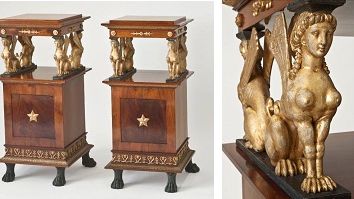
Press release -
New acquisition: Royal nightstands
This spring, Nationalmuseum acquired a pair of superb quality nightstands with royal provenance. The nightstands are veneered in mahogany, with blacked lion’s paw feet, gilded North Stars and four winged sphinxes. They are an important addition to the museum’s collection of Swedish furniture from the early 19th century.
It is most likely that the nightstands were made for Queen Hedvig Elisabet Charlotta’s large bedchamber at Rosersberg Palace, a room that was newly refurbished under the direction of architect Carl Christoffer Gjörwell in 1809–1810. Gjörwell took his inspiration from contemporary French volumes of prints, particularly Recueil de Décorations Intérieures by architects Charles Percier and Pierre-François-Léonard Fontaine.
When it comes to the nightstands however, it is Percier and Fontaine’s pupil, Louis Berthault, who provided the original model. In 1798–1799, Berthault had completed a much admired interior for banker Jacques Récamier, whose wife, Juliette Récamier, was one of the most fêted and famed figures of the age. Parts of Berthault’s designs, including Madame Récamier’s bedchamber, were published as plates in Plans coupés, élévations des plus belles maisons et des hôtels construits à Paris et dans les environs (by Jean-Charles Krafft and Nicolas Ransonnette), of which we know that Gjörwell himself owned a copy.
The newly acquired nightstands closely mirror those that stand in symmetry on either side of Madame Récamier’s bed. The nightstands are veneered in mahogany and stand on blacked lion’s paws. The doors are decorated with five-point gilt North Stars, while the almost square top is borne on four carved winged sphinxes. The other carved wooden details are also gilded. We have been unable to determine exactly who made these pieces, although they were clearly made in Stockholm, possibly by one of the great cabinetmakers Anders Lundelius, Fredrik August Eckstein or Carl Henrik Blom. The incredibly fine carvings may well have been the work of Pehr Ljung or his pupil Ernst Philip Thoman.
The royal provenance of the nightstands is supported by a note glued to the back of one of the stands, which says “Gift of 1 bed & 1 pair of nightstands from Carl XIV Johan to Conrad Th von Schultzenheim, Christineberg & Rockhammar…”. Conrad Theodor von Schultzenheim (1768–1837) was an officer who took part in King Karl XIV Johan’s German campaign against Napoleon in 1813. Karl XIV Johan probably inherited the nightstands from his adoptive father, King Karl XIII, who originally commissioned them for his wife Hedvig Elisabet Charlotta’s bedchamber at Rosersberg. When this bedchamber was refashioned as Queen Desirée’s drawing room in 1823 the bed, and most likely also the two nightstands that the museum has acquired, were moved out.
The nightstands are an important addition to the museum’s collection of Swedish furniture from the early 19th century, made possible with funds from the Axel Hirsch Foundation, the Friends of Nationalmuseum and an individual patron of the museum who wishes to remain anonymous. The new acquisitions are currently on display in the museum’s gallery of applied art and modern design.
Further information
Anders Bengtsson, curator applied art and modern design
anders.bengtsson@nationalmuseum.se, +46 8 5195 4385
Hanna Tottmar, press officer
hanna.tottmar@nationalmuseum.se, +46 8 5195 4390, +46 767 23 46 32
Press images
www.nationalmuseum.se/pressroom
Categories

